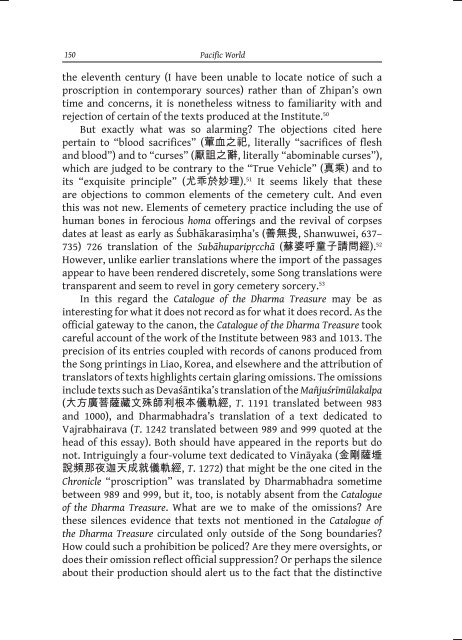Looking for Bhairava - The Institute of Buddhist Studies
Looking for Bhairava - The Institute of Buddhist Studies
Looking for Bhairava - The Institute of Buddhist Studies
- No tags were found...
You also want an ePaper? Increase the reach of your titles
YUMPU automatically turns print PDFs into web optimized ePapers that Google loves.
150Pacific Worldthe eleventh century (I have been unable to locate notice <strong>of</strong> such aproscription in contemporary sources) rather than <strong>of</strong> Zhipan’s owntime and concerns, it is nonetheless witness to familiarity with andrejection <strong>of</strong> certain <strong>of</strong> the texts produced at the <strong>Institute</strong>. 50But exactly what was so alarming? <strong>The</strong> objections cited herepertain to “blood sacrifices” ( 葷 血 之 祀 , literally “sacrifices <strong>of</strong> fleshand blood”) and to “curses” ( 厭 詛 之 辭 , literally “abominable curses”),which are judged to be contrary to the “True Vehicle” ( 真 乘 ) and toits “exquisite principle” ( 尤 乖 於 妙 理 ). 51 It seems likely that theseare objections to common elements <strong>of</strong> the cemetery cult. And eventhis was not new. Elements <strong>of</strong> cemetery practice including the use <strong>of</strong>human bones in ferocious homa <strong>of</strong>ferings and the revival <strong>of</strong> corpsesdates at least as early as Śubhākarasiṃha’s ( 善 無 畏 , Shanwuwei, 637–735) 726 translation <strong>of</strong> the Subāhuparipṛcchā ( 蘇 婆 呼 童 子 請 問 經 ). 52However, unlike earlier translations where the import <strong>of</strong> the passagesappear to have been rendered discretely, some Song translations weretransparent and seem to revel in gory cemetery sorcery. 53In this regard the Catalogue <strong>of</strong> the Dharma Treasure may be asinteresting <strong>for</strong> what it does not record as <strong>for</strong> what it does record. As the<strong>of</strong>ficial gateway to the canon, the Catalogue <strong>of</strong> the Dharma Treasure tookcareful account <strong>of</strong> the work <strong>of</strong> the <strong>Institute</strong> between 983 and 1013. <strong>The</strong>precision <strong>of</strong> its entries coupled with records <strong>of</strong> canons produced fromthe Song printings in Liao, Korea, and elsewhere and the attribution <strong>of</strong>translators <strong>of</strong> texts highlights certain glaring omissions. <strong>The</strong> omissionsinclude texts such as Devaśāntika’s translation <strong>of</strong> the Mañjuśrīmūlakalpa( 大 方 廣 菩 薩 藏 文 殊 師 利 根 本 儀 軌 經 , T. 1191 translated between 983and 1000), and Dharmabhadra’s translation <strong>of</strong> a text dedicated toVajrabhairava (T. 1242 translated between 989 and 999 quoted at thehead <strong>of</strong> this essay). Both should have appeared in the reports but donot. Intriguingly a four-volume text dedicated to Vināyaka ( 金 剛 薩 埵說 頻 那 夜 迦 天 成 就 儀 軌 經 , T. 1272) that might be the one cited in theChronicle “proscription” was translated by Dharmabhadra sometimebetween 989 and 999, but it, too, is notably absent from the Catalogue<strong>of</strong> the Dharma Treasure. What are we to make <strong>of</strong> the omissions? Arethese silences evidence that texts not mentioned in the Catalogue <strong>of</strong>the Dharma Treasure circulated only outside <strong>of</strong> the Song boundaries?How could such a prohibition be policed? Are they mere oversights, ordoes their omission reflect <strong>of</strong>ficial suppression? Or perhaps the silenceabout their production should alert us to the fact that the distinctive
















